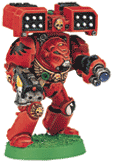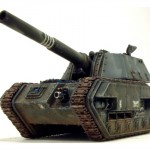
Hurr, hurr, youssa gonna die! (GW photo)
A notable aspect of my meta-gaming over the past couple months has been debating whether or not to phase out my Terminators. Sometimes they’re super effective. But they’re frequently hard to get into place, particularly as safe Deep Strike locations are typically limited on the terrain-heavy boards I usually play on, and smart opponents will take down Drop Pods with Locator Beacons before the Terminators arrive from Reserves. Often the Terminators are left just out of useful range as they huff and puff, running around the battle after Deep Striking, trying to catch up to their targets. I’m not super interested in meching up into Landraiders to deliver them, so this is a problem.
As part of that train of thought, I’m considering shifting my Terminators from a Deep Striking offensive unit into a static, hard group of defenders around a home objective. Under that plan, Terminators would deploy just forward of likely inbound paths, focus on shooting, and then step out to block any incoming push in order to stall it well forward of claiming the objective. Alternatively, the Terminators would hang out right around the objective and be in place to guard against outflanking units and those damn Space Wolves Scouts (which I believe can enter from your table edge).
As part of that, I’m thinking about quickly rigging up some sort of Cyclone Missile Launcher for one of my Terminators (not having one on hand), and replacing the squad’s Assault Cannon with that. I like the Assault Cannon, but it’s a legitimate question as to which is more useful. One way to start breaking this down is by the squad’s intended primary targets: Are they for killing vehicles, or infantry?
For vehicle hunting, the tradeoffs are fairly interesting. Four strength 6 shots with the Assault Cannon versus two strength 8 shots with the Krak Missile. It’s not super obvious which is better. Obviously, the Krak Missile has a chance to take down AV 14 vehicles, which the Assault Cannon just doesn’t. However, more realistically these guys would probably be shooting at light and medium vehicles. Rhinos, Chimeras, and Dreadnoughts are the ubiquitous examples there, so let’s look at them.
- Rhinos (AV 11 front/side):
- Assault Cannon
- 4*2/3 chance to hit (BS 4) = 2.667 hits
- 2.667 * 1/6 chance to penetrate = 0.444 penetrating hits
- 0.444 * 1/3 chance to wreck or explode = 14.8% chance of destroying AV 11
- Cyclone ML
- 2*2/3 chance to hit(BS 4)= 1.333 hits
- 1.333 * 1/2 chance to penetrate = 0.666 penetrating hits
- 0.666 * 1/3 chance to wreck or explode = 22.2% chance of destroying AV 11
- Chimeras and Dreadnoughts (AV 12 front):
- Assault Cannon works out the same as for AV11 due to Rending:
- 4*2/3 chance to hit(BS 4)= 2.667 hits
- 2.667 * 1/6 chance to penetrate = 0.444 penetrating hits
- 0.444 * 1/3 chance to wreck or explode = 14.8% chance of destroying AV 12
- Cyclone ML
- 2*2/3 chance to hit(BS 4)= 1.333 hits
- 1.333 * 1/3 chance to penetrate = 0.444 penetrating hits
- 0.444 * 1/3 chance to wreck or explode = 14.8% chance of destroying AV 12
- Predators (AV 13 front):
- Assault Cannon:
- 4*2/3 chance to hit(BS 4)= 2.667 hits
- 2.667 * 1/9 chance to penetrate (AP of 6 plus 2 or 3 rending, probability 1/6 times 2/3) = 0.296 penetrating hits
- 0.296 * 1/3 chance to wreck or explode = 9.9% chance of destroying AV 13
- Cyclone ML
- 2*2/3 chance to hit(BS 4)= 1.333 hits
- 1.333 * 1/6 chance to penetrate = 0.222 penetrating hits
- 0.222 * 1/3 chance to wreck or explode = 7.4% chance of destroying AV 13
Assuming all of that is correct, the Cyclone is a little bit better at popping Rhinos, but they’re equivalent against Chimeras and Dreadnoughts, and Assault Cannons are slightly better at Predators. That’s a tough call on which is better, though I’d give a slight edge to the practical utility and likelihood of popping Rhinos with the Cyclone ML.
For infantry killing it’s again a tough call. Straight-up against each other, I’d say the Assault Cannon is the clear winner. Even with the Cyclone’s blast template with the Frag Missile and placing two of them, I would not expect to routinely get three or four hits on target as I would expect from the Assault Cannon. Most opponents are just too good about keeping their squads spread out and in a nice linear formation you’re likely to scatter off. However, the Cyclone doesn’t replace the Terminator’s Storm Bolter and both can be fired at once, so at the same range as the Assault Cannon the model wielding the Cyclone will probably get the same number of hits.
Confusing the issue even further, the Assault Cannon has a heavier punch in general, particularly as compared to the Storm Bolter, but the Cyclone ML can get those two strong Krak Missile hits in. The Cyclone ML also has almost double the range.
All in all, I think all of the above means the Cyclone gets the slight edge, but these are very comparable weapons. I consider that an example of good game design—two equivalently costed options that don’t have a clearly stronger option, but favor two different styles of play and work best against slightly different enemies.
For me at this particular moment that means I can de-prioritize modeling work on a Cyclone ML for this weekend at ‘Ard Boyz in favor of more critical tasks. If I wind up rolling my existing Assault Cannon Terminator, it won’t be a big weakness or disadvantage comparing to fielding a new Cyclone Missile Launcher.

